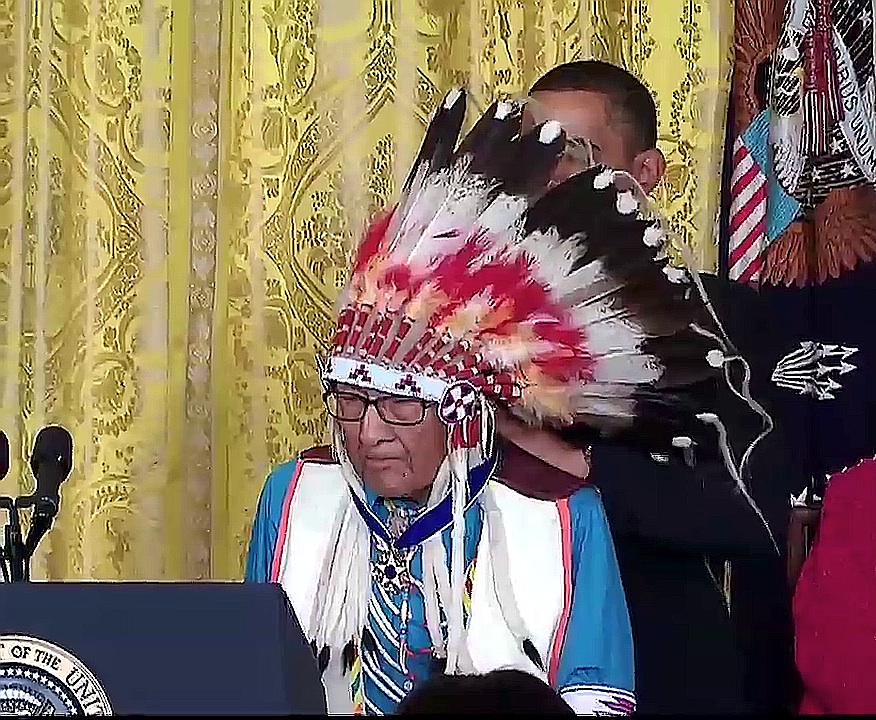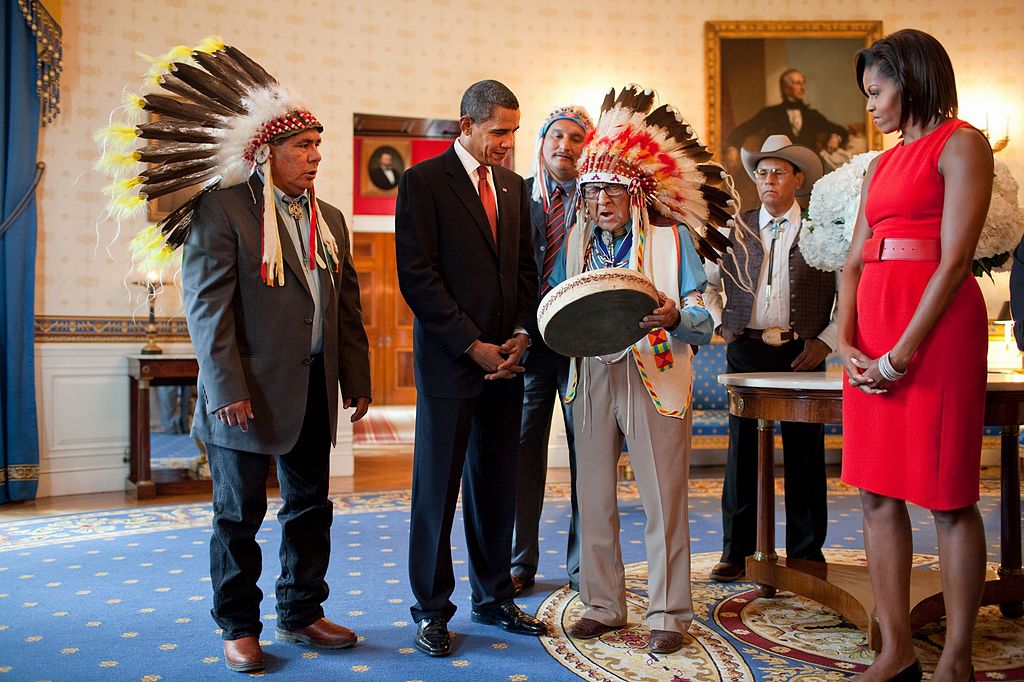A Warrior Born Into History
When Joseph Medicine Crow passed away in 2016 at the age of 102, the world didn’t just lose a decorated soldier and scholar, it lost the final living Plains Indian war chief, the last person to achieve a title rooted in hundreds of years of Indigenous warrior tradition.
Born on the Crow Reservation in Montana in 1913, Medicine Crow entered the world at a time when the way of life for many Native nations was rapidly disappearing under U.S. government policy. Yet he was raised in the traditions of his ancestors, surrounded by stories, rituals, and cultural teachings that had survived generations.
His lineage alone was extraordinary. One of his grandfathers, White Man Runs Him, served as a scout for General Custer before the Battle of the Little Bighorn. His other grandfather, Chief Medicine Crow, was revered as a formidable warrior. Growing up, young Joe listened to firsthand accounts of battles, learned to ride horses bareback, hunt, and endure harsh winters, all fundamentals of Crow warrior education.
These early teachings shaped not only his identity but his destiny. Although he lived in an era when the traditional expectations of war chiefs seemed impossible to fulfill, Joe Medicine Crow would eventually complete all four requirements, not on the plains of Montana, but on the battlefields of France and Germany during World War II.
What It Meant to Become a Plains War Chief
In the tradition of the Crow Nation, earning the title of war chief required completing four specific acts of bravery:
- Touch a living enemy in battle
- Take an enemy’s weapon
- Lead a successful war party
- Steal an enemy’s horse
For centuries, these deeds served as the highest markers of honor and courage. But by the 20th century, they were nearly impossible to achieve. Native Americans had been forced onto reservations, traditional warfare had ended, horses were no longer central to battle, and the warrior lifestyle had been systematically dismantled.
Still, the values of courage, discipline, and leadership endured among the Crow, and would guide Joe Medicine Crow as his life took an unexpected turn.

A Scholar Before a Soldier
Despite his warrior upbringing, Medicine Crow grew into a brilliant academic mind. Deeply inspired by the oral histories of his people, he pursued higher education and, in 1939, became the first member of the Crow Nation to earn a master’s degree. He studied anthropology and history, with the goal of preserving the stories and cultural legacy of the Crow.
But global conflict soon intervened. Before he could complete his doctorate, Medicine Crow left the University of Southern California to volunteer for the United States Army. Drawing from a long heritage of Crow scouts, the Army assigned him to a scouting role with the 103rd Infantry Division.
By 1944, he was deployed to Europe. And this is where the unlikely path to becoming a war chief began to unfold.
Carrying Tradition Into Battle
Before entering combat, Medicine Crow followed Crow tradition:
- He painted two red war stripes on his arms, concealed under his uniform.
- He carried a Yellow Eagle feather, gifted by a Sun Dance medicine man.
These symbols connected him spiritually to the warriors who came before him.
As he fought his way across France and into Germany, it seemed improbable, even impossible, that the traditional feats of the war chief could happen in modern warfare. But in the chaos of battle, each requirement found him.
Taking a Weapon and Touching an Enemy
Medicine Crow’s first two feats happened almost simultaneously.
During a raid in a small French town, he unexpectedly turned a corner and came face-to-face with a German soldier. In that instant, he knocked the enemy’s rifle from his hands, stealing a weapon, then subdued him, taking the man captive and fulfilling the requirement to touch a living enemy.
The encounter was fast, controlled, and deeply aligned with the warrior training of his youth.
Leading a War Party Under Fire
Although he was not normally in command roles, Medicine Crow found himself responsible for leading a dangerous mission when German forces surrounded his company. With ammunition running low and enemy fire closing in, his commanding officer ordered him to take charge of a small group of soldiers and retrieve critical supplies.
The journey required navigating land mines, dodging enemy fire, and maneuvering through hostile territory. Medicine Crow successfully led all seven men on the mission, ensuring the survival of the company.
With this, he completed the third requirement: leading a successful war party.
Only one feat remained, and in modern mechanized warfare, it seemed impossible.
The Nazi Horse Raid
Yet even the German army, renowned for its tanks and machinery, relied partly on horses in remote areas due to fuel shortages. Late in the war, during the disorganized German retreat, Medicine Crow noticed hoofprints in the mud and heard the unmistakable sound of horses fleeing with a group of SS soldiers.
Following the trail under moonlight, Medicine Crow and his company discovered a villa with a barn sheltering dozens of horses.
Before the attack, he approached his officer with a plan rooted in centuries of Crow tradition:
“Maybe I should get those horses out of the corral before you attack, because some of those SS guys might be able to escape on them.”
His commander agreed.
Moving swiftly and quietly, Joe slipped into the corral, crafted a makeshift bridle from rope, just as Crow warriors had done for generations, and mounted a horse. As he rode out, he stirred up the herd, creating a stampede of roughly 50 horses.
Chaos erupted among the SS soldiers. Artillery fire soon followed from the American division.
Riding through the moonlit night, Medicine Crow began to sing a traditional Crow victory song:
“I sang this song a little bit and rode around the horses. The horses looked at me. Finally, I left them in the woods.”
He had done it: he stole horses from enemy soldiers in wartime, completing the final requirement to become a war chief.
When he finally returned to his unit, his commander joked that he should dismount:
“You better get off. You make too good a target.”
The Germans surrendered soon after.

Recognition at Home and Around the World
After the war, Joe Medicine Crow returned to Montana, where the elders of the Crow Nation formally recognized him as a war chief, an honor almost no one of his generation could achieve.
He also earned military honors, including:
- The Bronze Star
- The French Legion of Honor
In 1948, he was appointed the official Crow Tribal Historian. For decades, he preserved Indigenous narratives, documented the Crow role in the Battle of the Little Bighorn, and wrote the script for the annual reenactment, based on the firsthand oral histories passed down to him.
Medicine Crow became a respected author, educator, and cultural ambassador, speaking around the world about Crow history, World War II, and Native American identity.
His achievements culminated in 2009, when President Barack Obama awarded him the Presidential Medal of Freedom, the highest civilian honor in the United States. At age 95, he performed a ceremonial dance at the White House after receiving the medal.
The Last War Chief
Joe Medicine Crow died in 2016, closing a chapter in American and Native history. His extraordinary life blended ancient warrior tradition with modern military service in a way no one else is likely to replicate.
Only one soldier, his nephew, Carson Walks Over Ice, a Green Beret in the Vietnam War, came close to the four traditional feats. He completed three but never stole a horse.
Carson joked:
“I did get two elephants, and that should have counted for something. But the elders did not see it my way.”
Today, Medicine Crow remains a towering figure not just in Crow history, but in the broader story of courage, cultural survival, and service. He embodied both the warrior ethos of his ancestors and the determination of a soldier fighting tyranny in the 20th century.
Through his scholarship, his storytelling, and his heroism, he ensured that the old ways, and the values behind them, would never be forgotten.
Featured Image From: Pete Souza, Public domain, via Wikimedia Commons

